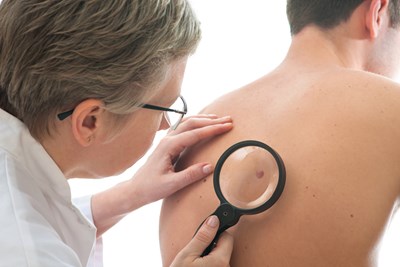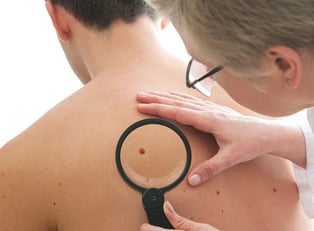General Skin Cancer Symptoms
Skin cancer is the most common form of cancer in the United States. It is also one of the few types of cancer that affects similar subsets of the population regardless of age, gender, or race. There are three different types of skin cancer: basal-cell carcinoma, squamous-cell carcinoma, and perhaps the most widely-known type, melanoma. The first two types are, by far, the most common forms of skin cancer. These two forms, while serious, do not typically spread. The third form, melanoma, is infamous because of its tendency to spread cancer throughout other areas of the body.
A common belief about skin cancer is that is caused by exposing unprotected skin to the harmful UV rays of the sun. While in most cases this belief is true, there have been cases of skin cancer that were not brought on by the sun. Skin cancer is actually a mutation that happens in the DNA in the cells of the skin. In some people who have this disease in parts of the body not typically exposed to the sun, the cause can be due to genetics, weakened immune systems, or being exposed to toxic substances in their environment.
General symptoms for any type of skin cancer include:
- Openings or cuts in the skin that do not heal
- Changes in any mole or skin growth, especially regarding color or size
Symptoms for Specific Types
The majority of basal-cell carcinoma appears around the face or neck. Symptoms of basal-cell carcinoma include pearly or waxy bumps. These bumps may bleed frequently or appear as a sore that does not eventually heal over time. Symptoms may also appear as flat, flesh-colored or red scar-like bumps or patches. While this type of skin cancer tends to be most commonly brought on by exposure to the sun, a family history of basal-cell carcinoma increases the likelihood of being diagnosed with the condition.
Squamous-cell carcinoma occurs most often on parts of the body that are regularly exposed to the sun. Symptoms include small red bumps that are well-defined and grow to increase in size. As they grow, the central portion of the bump collapses and a depression forms in the middle that may occasionally bleed. Bumps may also be scaly or patchy, similar in appearance to a wart surrounded by crusted skin. These legions may occasionally bleed as well, especially if bumped. Squamous-cell carcinoma has a higher risk of spreading to other parts of the body than basal-cell carcinoma, though not as high a risk as melanoma. However, the spread of this skin cancer type is typically more apparent in cases where tobacco or alcohol is the related cause.
Melanoma lesions can occur anywhere on the body, though they are particularly common on the legs and back. Symptoms of melanoma include brownish colored spots with irregular borders, moles that seem to change in size or color, or even moles that bleed. A common mnemonic to help recognize melanoma symptoms is "ABCDE:"
- Asymmetry – Melanoma lesions are not particularly defined. If you were to draw a line through the middle of the suspected area, the two halves would not match each other in shape.
- Border – Similar to asymmetry, the border of melanoma lesions are not clearly defined and tend to be uneven, wavering, and may be faded in some sections.
- Color – Suspect areas can be a variety of dark colors including brown, tan, and black. A variety of colors or a change in color within a single area is an important early warning sign of melanoma.
- Diameter – A good rule of thumb is that melanoma areas are often larger than the size of a pencil eraser, though they may be smaller upon first detection. Recommend your doctor examine any large moles or discolored areas of your skin.
- Evolving – Melanoma often changes over the course of time, especially in size and color. Take note of any changes in moles or other suspect areas and recommend them to your doctor for examination.



